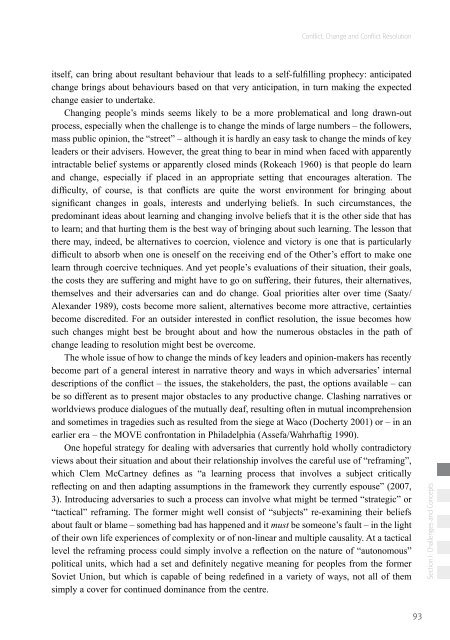Conflict, Change and Conflict Resolution - Berghof Handbook for ...
Conflict, Change and Conflict Resolution - Berghof Handbook for ...
Conflict, Change and Conflict Resolution - Berghof Handbook for ...
You also want an ePaper? Increase the reach of your titles
YUMPU automatically turns print PDFs into web optimized ePapers that Google loves.
<strong>Conflict</strong>, <strong>Change</strong> <strong>and</strong> <strong>Conflict</strong> <strong>Resolution</strong><br />
itself, can bring about resultant behaviour that leads to a self-fulfilling prophecy: anticipated<br />
change brings about behaviours based on that very anticipation, in turn making the expected<br />
change easier to undertake.<br />
Changing people’s minds seems likely to be a more problematical <strong>and</strong> long drawn-out<br />
process, especially when the challenge is to change the minds of large numbers – the followers,<br />
mass public opinion, the “street” – although it is hardly an easy task to change the minds of key<br />
leaders or their advisers. However, the great thing to bear in mind when faced with apparently<br />
intractable belief systems or apparently closed minds (Rokeach 1960) is that people do learn<br />
<strong>and</strong> change, especially if placed in an appropriate setting that encourages alteration. The<br />
difficulty, of course, is that conflicts are quite the worst environment <strong>for</strong> bringing about<br />
significant changes in goals, interests <strong>and</strong> underlying beliefs. In such circumstances, the<br />
predominant ideas about learning <strong>and</strong> changing involve beliefs that it is the other side that has<br />
to learn; <strong>and</strong> that hurting them is the best way of bringing about such learning. The lesson that<br />
there may, indeed, be alternatives to coercion, violence <strong>and</strong> victory is one that is particularly<br />
difficult to absorb when one is oneself on the receiving end of the Other’s ef<strong>for</strong>t to make one<br />
learn through coercive techniques. And yet people’s evaluations of their situation, their goals,<br />
the costs they are suffering <strong>and</strong> might have to go on suffering, their futures, their alternatives,<br />
themselves <strong>and</strong> their adversaries can <strong>and</strong> do change. Goal priorities alter over time (Saaty/<br />
Alex<strong>and</strong>er 1989), costs become more salient, alternatives become more attractive, certainties<br />
become discredited. For an outsider interested in conflict resolution, the issue becomes how<br />
such changes might best be brought about <strong>and</strong> how the numerous obstacles in the path of<br />
change leading to resolution might best be overcome.<br />
The whole issue of how to change the minds of key leaders <strong>and</strong> opinion-makers has recently<br />
become part of a general interest in narrative theory <strong>and</strong> ways in which adversaries’ internal<br />
descriptions of the conflict – the issues, the stakeholders, the past, the options available – can<br />
be so different as to present major obstacles to any productive change. Clashing narratives or<br />
worldviews produce dialogues of the mutually deaf, resulting often in mutual incomprehension<br />
<strong>and</strong> sometimes in tragedies such as resulted from the siege at Waco (Docherty 2001) or – in an<br />
earlier era – the MOVE confrontation in Philadelphia (Assefa/Wahrhaftig 1990).<br />
One hopeful strategy <strong>for</strong> dealing with adversaries that currently hold wholly contradictory<br />
views about their situation <strong>and</strong> about their relationship involves the careful use of “reframing”,<br />
which Clem McCartney defines as “a learning process that involves a subject critically<br />
reflecting on <strong>and</strong> then adapting assumptions in the framework they currently espouse” (2007,<br />
3). Introducing adversaries to such a process can involve what might be termed “strategic” or<br />
“tactical” reframing. The <strong>for</strong>mer might well consist of “subjects” re-examining their beliefs<br />
about fault or blame – something bad has happened <strong>and</strong> it must be someone’s fault – in the light<br />
of their own life experiences of complexity or of non-linear <strong>and</strong> multiple causality. At a tactical<br />
level the reframing process could simply involve a reflection on the nature of “autonomous”<br />
political units, which had a set <strong>and</strong> definitely negative meaning <strong>for</strong> peoples from the <strong>for</strong>mer<br />
Soviet Union, but which is capable of being redefined in a variety of ways, not all of them<br />
simply a cover <strong>for</strong> continued dominance from the centre.<br />
93<br />
Section I: Challenges <strong>and</strong> Concepts
















